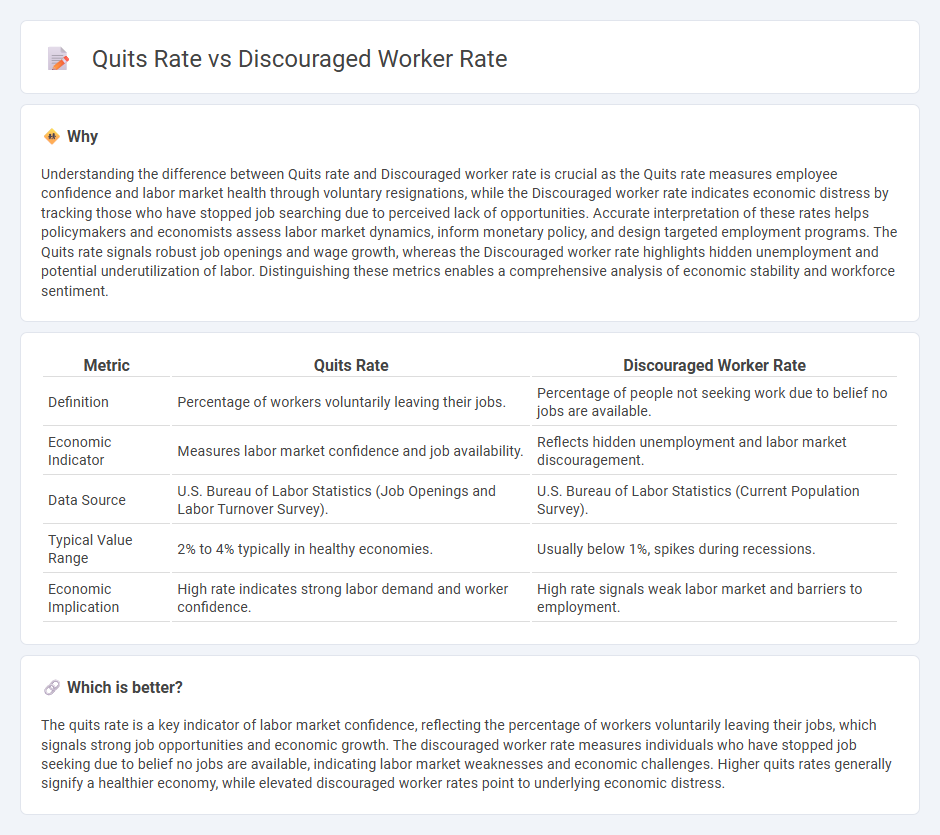
The quits rate measures the percentage of workers voluntarily leaving their jobs, indicating confidence in finding new employment opportunities. The discouraged worker rate captures those who have stopped searching for work due to perceived lack of job prospects, reflecting underlying labor market challenges. Explore how these metrics reveal the true health of the economy and workforce dynamics.
Why it is important
Understanding the difference between Quits rate and Discouraged worker rate is crucial as the Quits rate measures employee confidence and labor market health through voluntary resignations, while the Discouraged worker rate indicates economic distress by tracking those who have stopped job searching due to perceived lack of opportunities. Accurate interpretation of these rates helps policymakers and economists assess labor market dynamics, inform monetary policy, and design targeted employment programs. The Quits rate signals robust job openings and wage growth, whereas the Discouraged worker rate highlights hidden unemployment and potential underutilization of labor. Distinguishing these metrics enables a comprehensive analysis of economic stability and workforce sentiment.
Comparison Table
| Metric | Quits Rate | Discouraged Worker Rate |
|---|---|---|
| Definition | Percentage of workers voluntarily leaving their jobs. | Percentage of people not seeking work due to belief no jobs are available. |
| Economic Indicator | Measures labor market confidence and job availability. | Reflects hidden unemployment and labor market discouragement. |
| Data Source | U.S. Bureau of Labor Statistics (Job Openings and Labor Turnover Survey). | U.S. Bureau of Labor Statistics (Current Population Survey). |
| Typical Value Range | 2% to 4% typically in healthy economies. | Usually below 1%, spikes during recessions. |
| Economic Implication | High rate indicates strong labor demand and worker confidence. | High rate signals weak labor market and barriers to employment. |
Which is better?
The quits rate is a key indicator of labor market confidence, reflecting the percentage of workers voluntarily leaving their jobs, which signals strong job opportunities and economic growth. The discouraged worker rate measures individuals who have stopped job seeking due to belief no jobs are available, indicating labor market weaknesses and economic challenges. Higher quits rates generally signify a healthier economy, while elevated discouraged worker rates point to underlying economic distress.
Connection
The quits rate and discouraged worker rate are interconnected indicators of labor market health, with the quits rate reflecting employee confidence in finding better job opportunities, while the discouraged worker rate signals the number of individuals who have stopped seeking employment due to poor job prospects. A rising quits rate typically correlates with a strong economy and low unemployment, as workers feel empowered to leave jobs for improved conditions; conversely, an increase in discouraged workers often indicates economic weakness and labor market slack. Analyzing these metrics together provides insights into worker sentiment and overall economic resilience.
Key Terms
Labor force participation
The discouraged worker rate measures the percentage of individuals who have stopped seeking employment due to belief that no jobs are available, directly impacting the labor force participation rate by reducing active job seekers. In contrast, the quits rate reflects the percentage of employees voluntarily leaving jobs, often signaling confidence in labor market conditions and affecting workforce dynamics differently. Explore how these metrics interplay to shape labor force participation trends and economic health.
Voluntary separations
The discouraged worker rate measures individuals who have stopped looking for work due to belief no jobs are available, reflecting hidden unemployment not captured in the quits rate. The quits rate, representing voluntary separations from employment, serves as a key indicator of worker confidence and labor market fluidity. Explore further to understand how these metrics together shape labor market analysis and economic health.
Unemployment
The discouraged worker rate measures individuals who have stopped job seeking due to believing no jobs are available, reflecting hidden unemployment not captured by official labor force statistics, while the quits rate tracks voluntary job separations indicating worker confidence and labor market dynamism. Higher discouraged worker rates often signal economic distress and underutilized labor resources, whereas rising quits rates typically correspond to a robust job market with ample opportunities. Explore how these metrics interact to provide a fuller picture of unemployment and labor market health.
Source and External Links
Discouraged worker - Discouraged workers are individuals who have stopped looking for work because they believe no jobs are available for them; they are not counted in the official unemployment rate but are considered marginally attached to the labor force.
Discouraged Workers | Definition, Characteristics & Effects - The discouraged worker rate includes people not currently working who want a job and have looked in the past year but have stopped searching recently, thus they are excluded from the official unemployment rate and affect labor force statistics by making the unemployment rate appear lower than the true labor market slack.
United States - Total Unemployed Plus Discouraged Workers (U-4) - As of May 2025, the total unemployed plus discouraged workers rate (U-4) in the U.S. was 4.50%, which includes unemployed people along with discouraged workers relative to the civilian labor force plus discouraged workers.
 dowidth.com
dowidth.com